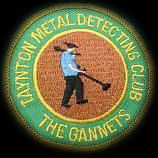
Tokens
Introduction
Jetons
Lead Tokens
Trade Tokens
Checks
17th Century
Taynton Metal Detecting Club
The Gannets
Introduction to Tokens
Until the 19th Century most coins contained metal worth the value at which they circulated. A token was a peice of money whose metal value was less than its face value. Tokens were typicaly used as an unofficial low value coinage, particularly when offical coinage was in short supply. Strictly speaking all modern coins are tokens, they just differ from earlier tokens in being official coinage.
Jetons
Jetons were tokens or coin-like medals produced across Europe from the 13th through the 17th centuries. They were produced as counters for use in calculation on a lined board or cloth similar to an abacus. The word jeton comes from the French verb "jeter", used in the sense of "to push", because the counters were pushed over the abacus during a calculation. They also found use as a money substitute in games, similar to modern casino chips or poker chips. Thousands of different jetons exist, mostly of religious and educational designs, as well as portraits, these most resembling coinage. The earliest English jetons belong to the year 1280. After the series struck following the reign of Edward 1, the production of English jetons diminished and in the 14th century French jetons were imported in large quantities. In the 15th century the manufacturing of jetons was concentrated in France and the Low Countries (now Belgium and Holland). There were two types: official jetons ordered by a special administration of a prince or a town, and common cheap ones for general use. The first type bears the names, arms and badges of their users; the common type is often an imitation of an official one. In the 16th century a very large proportion of the counters for common use in Europe were manufactured at Nuremberg, Germany. Jetons became widely used as small change.
Lead Tokens
Lead tokens appear to have been used in Britain from the late-13th century to the mid-19th century. The start of this period is when fractional denominations were first introduced, with pennies being cut into halves and quarters, and the end is the period during which the Government first successfully overcame the shortage of small change which had plagued the country for several centuries. This may or may not be coincidence. Even the smallest official coin, the farthing, was a significant portion of a man's weekly wage, and hence practicality drove communities to resolve a situation which the authorities were not able to. No official record survives of who struck them where, what they were valued at or under what local agreement they circulated; they probably had a very limited geographic radius of use and were probably struck or cast by some such craftsman as the local blacksmith. Not all lead tokens would have been money; some of them were almost certainly passes, whilst others will have had their value defined in terms of commodities or services rather than the currency of the day. The earliest pieces, c.1275-1500, tended to be pewter rather than pure lead and were almost certainly of ecclesiastical origin. Later pieces are usually pure lead, typically increasing to about 15-17mm in the Civil War period and often up to around 25mm in the 18th century. There is little identification on crude lead tokens to offer much hope to the genealogist or historian; noplacename, a couple of initials occasionally, and often not that. The designs are various. A few appear repeatedly, such as the flower of six petals, the cartwheel, the lis and the anchor.
Trade Tokens
Trade Tokens are privately produced substitutes for official coins. They were produced in Britain from the reign of Elizabeth I to that of George III, by companies or individuals, to provide change. They reached their peak near the end of the 19th century. Monarchs usually held a monopoly on the minting and issuing of coins. This was normally a profitable activity, but the production cost of small coins often made them unprofitable to produce. Because of this, many monarchs neglected to produce sufficient quantities of low denomination coins to meet demand. Many of the issuers of tokens were large employers who needed quantities of small change to pay wages. At their own cost, they produced their own "coins", usually with their nominal or face value inscribed on them, and the name of the issuers.
Checks and Tallies
Checks were tokens used to gain entrance. Tallies were tokens used to count the number of people or goods in a place e.g. miners would leave a tally behind before going underground and collect one on returning.
By club member David Mayes.